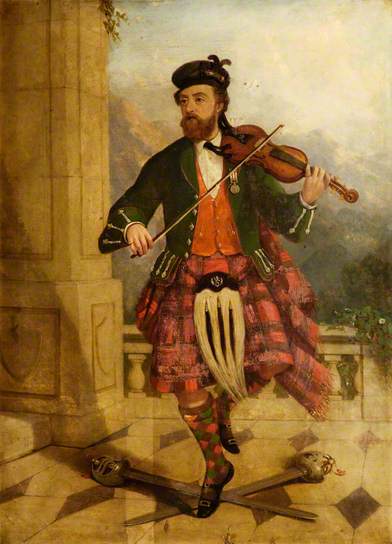Annotation:Alex Sandy Skinner: Difference between revisions
m (Text replacement - "<p><font face="sans-serif" size="2">" to "<p><font face="sans-serif" size="3">") |
No edit summary |
||
| (One intermediate revision by one other user not shown) | |||
| Line 1: | Line 1: | ||
---------- | |||
{{TuneAnnotation | |||
|f_tune_annotation_title= https://tunearch.org/wiki/Annotation:Alex_Sandy_Skinner > | |||
|f_annotation='''ALEX SANDY SKINNER'''. AKA - "(Alex) Sandy F. Skinner." Scottish, Canadian; Reel (cut time). Canada, Cape Breton. A so-called 'double-tonic' tune composed in 1934 by Aberdeen fiddler and composer J. Murdoch Henderson (1902-1972), who has been named by some as the greatest exponent of the Scottish fiddle in the 20th century, and creator of the first index of fiddle music collections. | |||
---- | |||
---- | |||
'''ALEX SANDY SKINNER'''. AKA - "(Alex) Sandy F. Skinner." Scottish, Canadian; Reel (cut time). Canada, Cape Breton. A so-called 'double-tonic' tune composed in 1934 by Aberdeen fiddler and composer J. Murdoch Henderson (1902-1972), who has been named by some as the greatest exponent of the Scottish fiddle in the 20th century, and creator of the first index of fiddle music collections. | |||
<br> | <br> | ||
<br> | <br> | ||
| Line 42: | Line 34: | ||
<br> | <br> | ||
The tune was in the repertoire of Winston Fitzgerald (1914-1987, Cape Breton), whose recording helped to popularize the reel among Cape Breton fiddlers. | The tune was in the repertoire of Winston Fitzgerald (1914-1987, Cape Breton), whose recording helped to popularize the reel among Cape Breton fiddlers. | ||
|f_source_for_notated_version= | |||
|f_printed_sources=Cranford ('''Winston Fitzgerald'''), 1997; No. 153, p. 61. Henderson ('''Flowers of Scottish Melody'''), 1935; p. 29. | |||
|f_recorded_sources=Celtic 042 (78 RPM), Winston "Scotty" Fitzgerald. | |||
|f_see_also_listing=Alan Snyder's Cape Breton Fiddle Recordings Index [https://www.cbfiddle.com/rx/tune/t1612.html]<br> | |||
}} | |||
Alan Snyder's Cape Breton Fiddle Recordings Index [https://www.cbfiddle.com/rx/tune/t1612.html]<br> | |||
Latest revision as of 00:43, 15 August 2023
X: 1 T: Alex Sandy Skinner C:J. Murdoch Henderson R:Reel I:speed 232 Q:232 F:http://www.math.mun.ca/~bshawyer/reels/AlexSandySkinner K:F M:4/4 L:1/8 |:((3ABc) cB AFFB|A2 FA cfcB|((3ABc) cB AFFA|G2_EG B_eBG| ((3ABc) cB AFFB|A2 FA cfeg|afeg fcAc|G2_EG B_e BG:| |:Acce fccB|AFFB ABcB|Accf afcA|G_EEB GABG| ABce fcfa|fdcB ABcA|BcdB Acfa|g2_EG B_eBG:|
ALEX SANDY SKINNER. AKA - "(Alex) Sandy F. Skinner." Scottish, Canadian; Reel (cut time). Canada, Cape Breton. A so-called 'double-tonic' tune composed in 1934 by Aberdeen fiddler and composer J. Murdoch Henderson (1902-1972), who has been named by some as the greatest exponent of the Scottish fiddle in the 20th century, and creator of the first index of fiddle music collections.

Competition of Scottish Music.–On Friday evening [21st April 1856], Mr Skinner gave a musical entertainment, including a competition by violin players from different parts of the country. The entertainment consisted of singing and piano-forte playing by Miss Wilson and Miss M. Wilson–both of whose efforts were very well received. Mr Skinner himself played the solos for which he was recently awarded a prize at Edinburgh, effectively, and to the satisfaction of the audience. For the prizes, 15 competitors entered the lists for reel and strathspey playing, and 8 for slow airs. They were Messrs William Blair and James Blair, Balmoral; Forbes Morrison, Tarves; John Thomson, George Paterson, Peter Milne, John Melvin, Sen., Alexander Adam, J. Nisbet, A. Wilson, John Melvin, Jun., Andrew Henry, and John Smart, Aberdeen; George Gaul, Whitehouse, Tarland; and Mr Hardie, Knockespock. The Judges were Messrs John Marr and William Smith, Aberdeen; Alexander Walker, Castle Newe, Strathdon; and David Mortimer, Birse. The competitors played behind a screen, where they were sufficiently heard by the audience and yet not seen by the Judges. The playing generally was not of so high an order as might have been expected. There were several pretty good reel players, but there were only two or three performers who could lay claim to much ability at slow airs. The first prizeman, however, played admirably. The Judges awarded prizes as follows: –
For Strathspey and Reel–1st prize (Silver Medal), P. Milne, Aberdeen; 2d (Silver Medal), Forbes Morrison, Tarves; 3d (Fiddle Bow), G. Patterson [sic[, Aberdeen; 4th (Merit), A. Henry, do.
For Slow Airs–1st prize (Silver Medal), P. Milne, Aberdeen; 2d (Merit), J. Nisbet, do.
–The after part of the entertainment consisted of the competitors playing before the audience in solo and combination. There was a considerable audience.
Sandy married Madame de Lenglée, also a dancing master, who survived him and who later joined J. Scott Skinner and his daughter in running their dancing classes.
The tune was in the repertoire of Winston Fitzgerald (1914-1987, Cape Breton), whose recording helped to popularize the reel among Cape Breton fiddlers.

